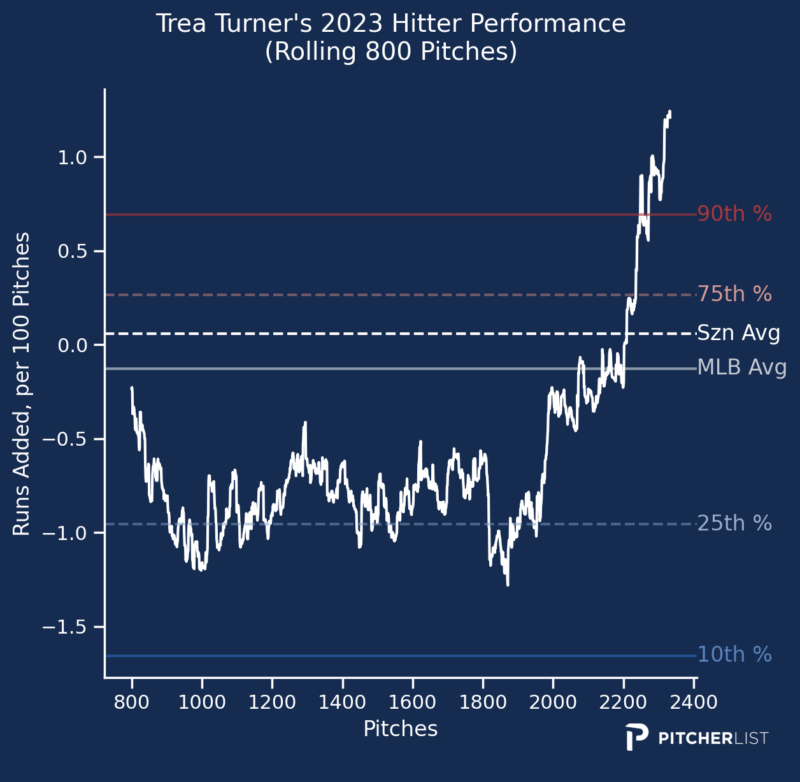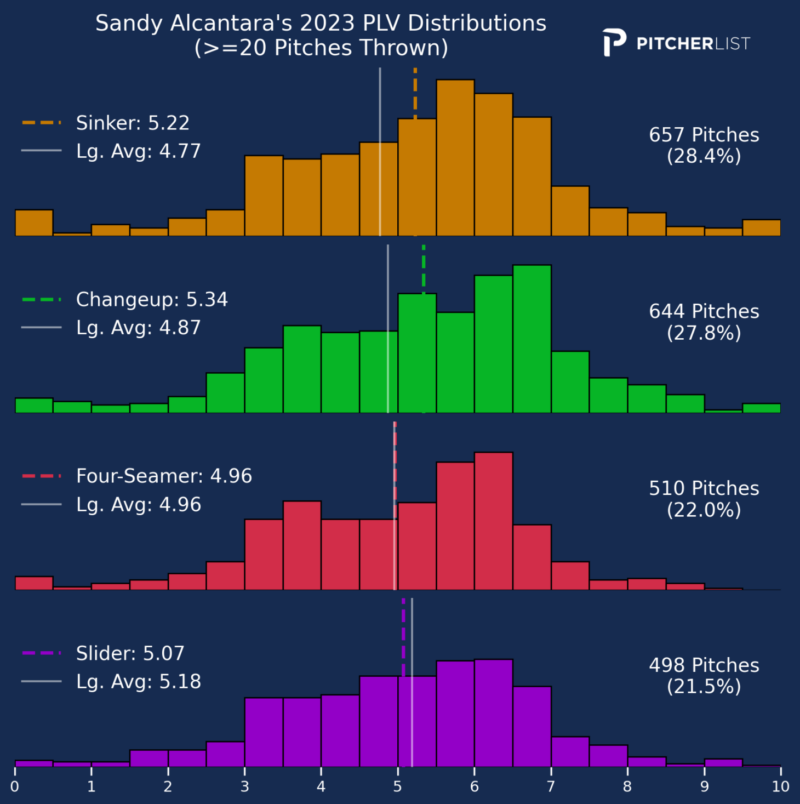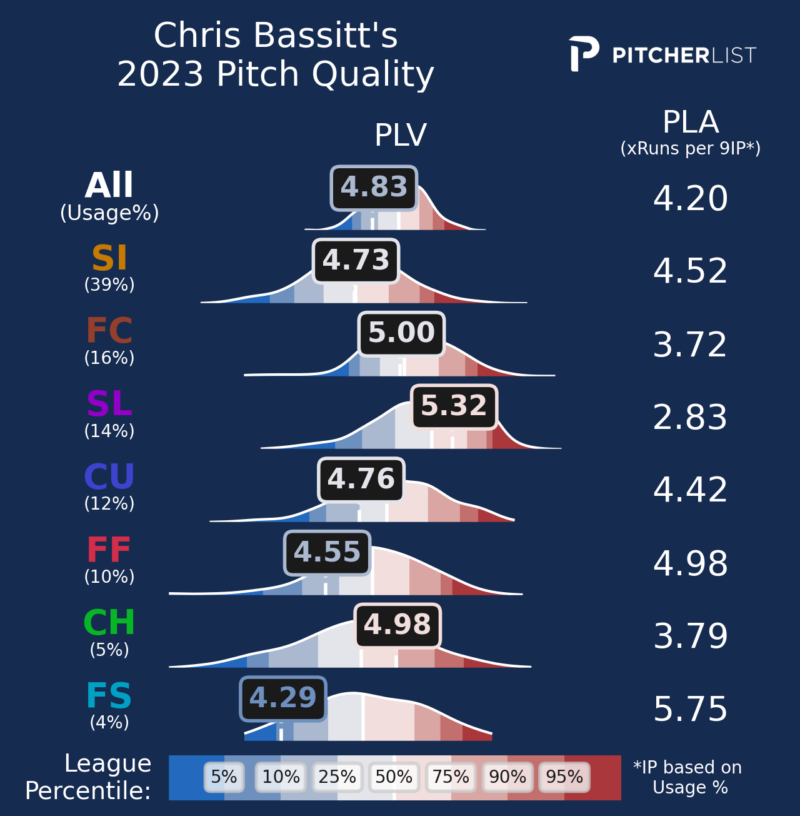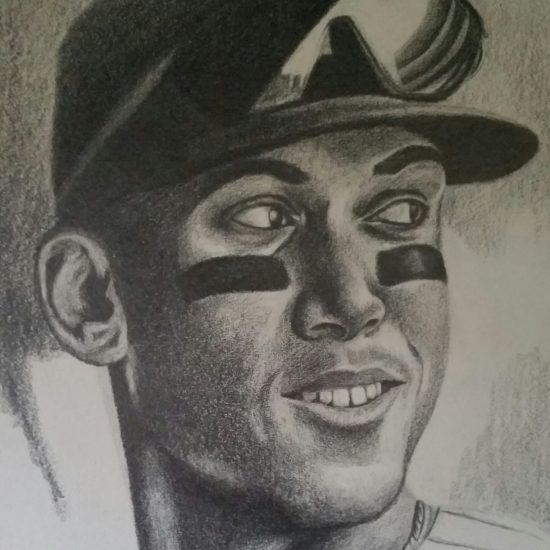This past offseason, Pitcher List introduced Pitch Level Value, or PLV, a new metric that assesses player performance by grading outcomes relative to the quality of the pitch. If you’re new to it, you can read Nick Pollack’s primer on PLV here.
You’ll find the definitions below. Grades are on a 20-80 scale.
Swing Aggression: How much more often a hitter swings at pitches, given the swing likelihoods of the pitches they face.
Strikezone Judgement: The “correctness” of a hitter’s swings and takes, using the likelihood of a pitch being a called strike (for swings) or a ball/HBP (for takes).
Decision Value (DV): Modeled value (runs per 100 pitches) of a hitter’s decision to swing or take, minus the modeled value of the alternative.
Contact Ability: A hitter’s ability to make contact (foul strike or BIP), above the contact expectation for each pitch.
Power: Modeled number of extra bases (xISO on contact) above a pitch’s expectation, for each BBE.
Hitter Performance (HP): Runs added per 100 pitches seen by the hitter (including swing/take decisions), after accounting for pitch quality.
Pitch Level Value (PLV): Estimated value of all pitches, based on the predicted outcome of those pitches (0-10, 5 is league average, PLV is not adjusted for pitch type).
Pitch Level Average (PLA): Value of all pitches (ERA Scale), using IP and the total predicted run value of pitches thrown.
Pitch type PLA: Value of a given pitch type (ERA scale), using total predicted run values and an IP proxy for that pitch type (pitch usage % x Total IP).
(Note: All stats are current through Thursday, 9/07).
In six starts since returning from the IL with a baulky shoulder, Woodruff has posted a sublime 2.78 ERA, 0.76 WHIP, and 25.4% K-BB while earning a 5.25 PLV.
You know with Woodruff it all starts with the fastball in which case seeing it at a 5.39 PLV for the year is precisely what we want to see; last season, his heater earned a 5.25 PLV.
His fastball’s 2.28 pitch-type PLA is the fourth-best among all pitchers with at least 500 pitches thrown. Yes, even better than Spencer Strider (2.43) and Zack Wheeler (2.36). Granted, the sample size is much smaller (648 pitches) but you get the idea; Woodruff’s heater is back and it’s better than ever. And it’s just in time for the playoff crunch for the Brewers and fantasy teams alike. Like Tupelo honey, things are rarely so perfect.
Unfortunately, the Yankees were off on Gleyber Day. Regardless, the Yankee second baseman has been rolling lately hitting .350 with a 1.272 OPS over the last 15 days (11 games). And having gone yard this past Thursday, he’s now surpassed last year’s total of 24 home runs. Torres has been slightly less aggressive at the dish this season (-1.4% swing aggression) compared to last year (0.4%) also noted by a small bump in his walk rate. Overall, he seems to be swinging at better pitches reflected by an increase in decision value from 55 to 60 along with now average contact ability (45 last year). His power according to PLV, though, has actually dropped a touch from 60 to 55.
It feels like we’re at “he is who he is” territory with Torres but there are a couple of modest improvements that might suggest he’s on the verge of a peak season heading into his final arbitration year; and yeah, that’s of course ignoring his wild 2019.
The 30-year-old rookie has been a lone bright spot for the Mets this season. His latest outing against the Mariners was another gem: seven innings, 12 strikeouts, and one earned run on five hits. The performance (104 pitches) earned a fantastic 5.30 PLV. Senga’s ghost fork has been off the charts earning a 5.55 PLV. Its 2.31 pitch-type PLA (PLV on an ERA scale) is second only to Chris Martin among all pitchers with at least 500 pitches thrown.
The words consistent and splitter go together, in my mind at least, like oil and water. Nonetheless, I’m stricken by the PLV scores of Senga’s splitter during his most recent four starts beginning from the aforementioned one against the Mariners (9/1): 5.55, 5.57, 5.60, and 5.61. Hopefully, I didn’t just jinx his next start which is tonight against the Twins. My apologies in advance.
Fantasy managers and Phillies fans endured an abominable first half from the star shortstop during which he slashed .247/ .299/ .389. But, yeah things change fast, don’t they? That might be an understatement as Turner has gone yard seven times over his last ten games, good for a 1.000 SLG. One notable change in his profile relative to last year is a dip in contact ability from 55 to 45. Either way, let’s enjoy this sight for sore eyes.

Over the last 15 days (11 games), the 24-year-old rookie leads baseball with a 1.514 OPS. Just think, only six summers ago he was drafted 849th overall out of Easter Voorhees High School in New Jersey. And now he’s helping the Jays peck their way to the playoffs as their cleanup hitter. Woah!
The mustachioed superstar in the making posted a .421 wOBA and 141 wRC+ across 87 games with Triple-Buffalo earlier this year, so this isn’t necessarily out of nowhere. The sample size is slim (330 pitches) but let’s have some fun. So far he’s earned a 60 in SZ Judgement, 70 in DV, along with 80-grade power and an 80 in HP. He’s shown a very passive approach at the plate with a -9.8% swing aggression; on that note, he had an 18.4% BB rate in the minors this season. The stick in the mud? A perilously low 20 in contact ability.
Sandy Alcantara
A forearm strain has in all likelihood ended the Sandman’s season. Hopefully, he can come back alright next year but in the meantime, we can put a bow on his year. The results on the surface weren’t there relative to last year’s brilliant Cy Young season and at least one thing that sticks out is a big drop in his LOB% from 78.8% to 69.6%. Variance is always a part of it.
The pitch quality metrics for his sinker (5.26 PLV) and changeup (5.19 PLV) were still excellent and comparable to last year.
The one dip, though, was with his slider (5.10 PLV). The interesting thing, though, was that his slider had a 17.5% SwStr% this year, two ticks higher than last year. That aside, if you look at his distributions below, you’ll see that his slider drifted toward below the league average. Considering the movement profile of his slider was pretty similar to last year, it seems as if his overall command of the pitch simply wasn’t as sharp, i.e. too many that were poorly located.

Bassitt proved that revenge is indeed a dish best served cold with a dominant effort against his former team out in Oakland. One thing I admire about Bassitt is that he’s eighth with 173.1 innings pitched. Availability is the best ability, right?
That aside, the PLV machine is a tough grader and it wasn’t a huge fan of the performance against the A’s (97 pitches) tabbing it with an underwhelming 4.68 PLV so there might’ve been some good fortune given it was, you know, the A’s and all. The start seems like a microcosm of Bassitt’s season; although his 3.69 ERA and 1.18 WHIP are similar to last year, his overall PLV has declined from 5.04 to 4.83 this year.

Bassitt yields an eclectic arsenal featuring seven different pitch types but as you can see above, his slider is the only one that rates above average in terms of pitch quality. Knowing that he relies a lot on his secondary pitches, the notable declines have been with his curveball (5.27 PLV to 4.76 PLV) and his cutter (5.21 PLV to 5.00 PLV). Granted, he’s done well despite the drop-offs but this is certainly something to keep in mind when looking ahead to next season.
Suzuki has come alive for the Cubs hitting .379 with a 1.150 OPS over his last 15 games.

For the season, he’s hitting .278 with a .817 OPS, so pretty good numbers overall. His PLV profile is also solid across the board: 55 in SZ Judgement, 55 in DV, 50 in contact ability, 55 in power, and 60 in HP. Given that he struggled to meet expectations last season and had a prolonged rough stretch this year (he hit .177 in June which you can see above) maybe there’s a chance he goes relatively overlooked next draft season. Also worth noting he dealt with injuries this year and last year. Regardless, he’s an intriguing player to watch the rest of the way, especially if this recent surge is more indicative of his true talent level.
Photo by Joe Robbins/Icon Sportswire | Adapted by Justin Paradis (@JustParaDesigns on Twitter)

